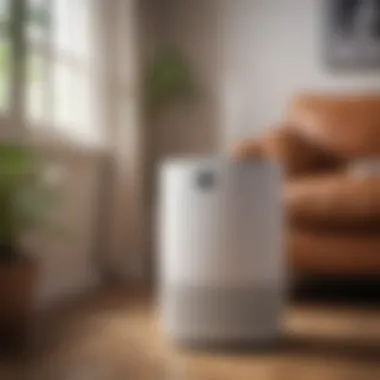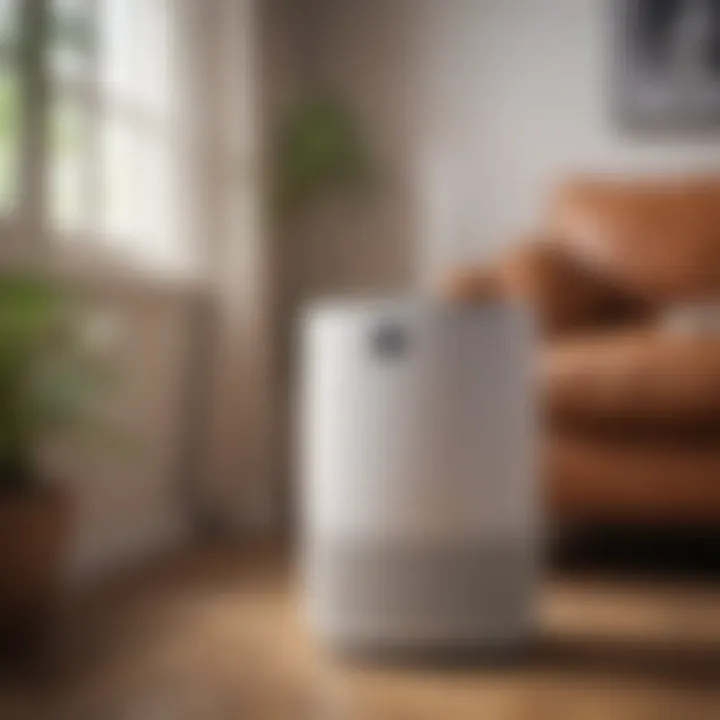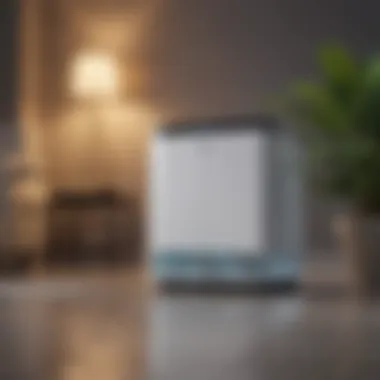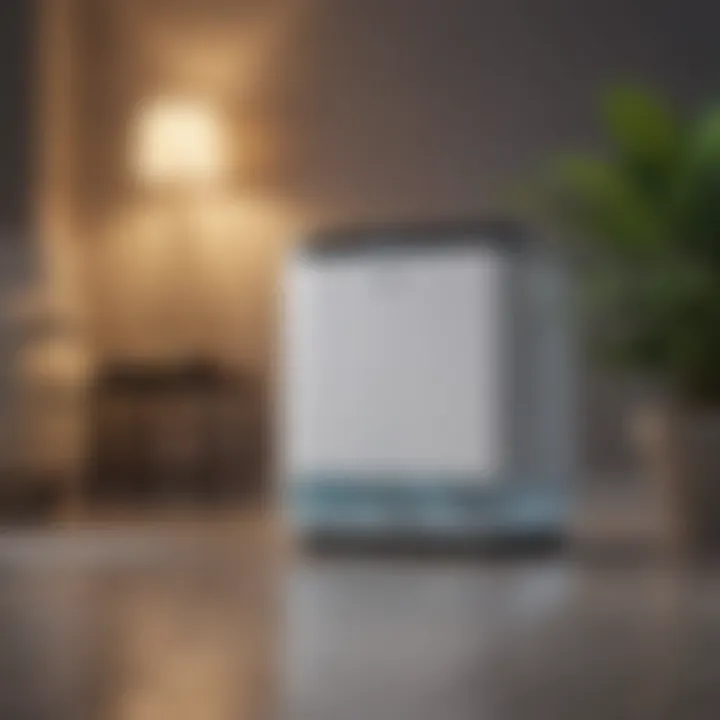Top Air Purifiers for Large Rooms: A Buying Guide


Intro
As the world becomes an increasingly crowded space, the importance of clean air in large living environments cannot be overstated. Whether it’s a sprawling home or a roomy office, ensuring that the air quality is up to par is vital for health and well-being. Pollutants, allergens, and odors can linger in large rooms, transforming a comfortable atmosphere into a potentially hazardous one. This comprehensive guide dives into the offerings of the market, focusing on top-tier air purifiers that are specially designed for expansive spaces. We’ll unravel the features and functionalities available, along with performance metrics and filter types that are essential for maintaining a breath of fresh air.
Design Inspiration
Creating an inviting atmosphere in large spaces isn’t just limited to furniture and wall paint. Air purifiers can also play a significant role in design, harmonizing functionality with aesthetics.
Current Interior Design Trends
The trends today hinge on minimalism and practicality. Air purifiers have transitioned from being mere appliances to stylish fixtures. Sleek designs integrate effortlessly into homes, embodying clean lines and modern finishes. For example, a purifier finished in brushed steel or matte black doesn't just purify air; it acts as an accent piece in your living room or study.
Color Palettes and Their Effects
Color choices extend beyond mere preferences. Soft colors like greens and blues can invoke feelings of calmness, enhancing the ambient atmosphere. Air purifiers in these tones can blend in flawlessly, serving both purpose and design aesthetic. Additionally, having an air purifier in a contrasting color can serve as a statement piece, standing out against a neutral palette.
"The right color can completely change your mood and enhance the functionality of a room."
Understanding Air Purification
When selecting an air purifier for large spaces, it's essential to understand the technology behind these machines.
Types of Filters
There are various filter types that cater to different needs:
- HEPA Filters: Known for trapping 99.97% of particles as small as 0.3 microns, they are a cornerstone in air purification.
- Activated Carbon Filters: These filters are excellent for absorbing odors, making them ideal for areas where cooking or pets are prevalent.
- UV-C Light Filters: Utilizing ultraviolet light, these filters help eliminate bacteria and viruses, adding a layer of safety for residents.
Performance Metrics
Performance is key for large rooms. Look for features like:
- CADR (Clean Air Delivery Rate): This measures how quickly an air purifier can clean the air in a given room size.
- Coverage Area: Ensure it matches your room’s dimensions, allowing for efficient filtration.
- Noise Levels: Large rooms can often require multiple units, but a quiet operation is essential for comfort.
Culmination
Equipped with the knowledge of design integration and the technicalities of air purifiers, homeowners can make informed choices that not only enhance air quality but also complement their interior spaces. As we continue through this guide, we’ll delve deeper into specific product recommendations, highlighting those that shine in performance and aesthetics. This blend of insight allows for a holistic approach towards creating a healthier living environment in larger areas.
Preface to Air Purification
Air purification is much more than a passing trend; it's a necessity for modern living. As we spend an increasing amount of time indoors—whether it's at home, in the office, or any other indoor environment—maintaining a healthy air quality becomes imperative. Understanding the implications of indoor air pollution is essential not just for general comfort, but for safeguarding one’s health and wellbeing.
Understanding Air Quality
Air quality can fluctuate dramatically based on various factors including location, season, and even the materials used in construction. While outdoor air quality is often a subject of media attention, many forget that indoor air can be up to five times more polluted. Common culprits include dust, pet dander, mold, and volatile organic compounds (VOCs) found in many household cleaning products.
For homeowners, this is particularly concerning. Poor air quality can trigger allergies, exacerbate respiratory issues, and even affect mental clarity. It's critical to know what's lurking in the air of your home, which can sometimes feel like an invisible adversary. By paying attention to air quality indicators, individuals can take proactive measures to protect themselves and their families.
Here are some key indicators of poor indoor air quality:
- High levels of dust accumulation
- Frequent respiratory issues among occupants
- Musty odors, suggesting mold presence
- Visible condensation on windows or walls
Importance of Air Purifiers
Air purifiers serve as a formidable line of defense against indoor air pollution. They work to remove contaminants, providing a fresh and cleaner breathing environment. The importance of air purifiers extends beyond mere convenience; they play a pivotal role in long-term health benefits.
Consider the comfort and health impacts for those prone to allergies or asthma. An effective air purifier can filter out allergens like pollen and mold spores, potentially reducing symptoms and creating a safer living space. Furthermore, air purifiers can help mitigate unpleasant odors, making homes feel fresh.


"A breath of clean air can be a game changer for those dealing with indoor air quality issues."
Beyond comfort, it’s vital to recognize that high-quality air purifiers contribute to increased energy levels and productivity, particularly in large rooms where stagnant air can lead to fatigue or distractions. By investing in a good purifier, you’re not just enhancing air quality; you’re investing in a healthier, more vibrant lifestyle.
Criteria for Selecting Air Purifiers for Large Rooms
Choosing the right air purifier for large rooms is not just a matter of picking a model off the shelf and plugging it in. It requires thoughtful consideration of various criteria that ensure optimal performance and satisfaction. As indoor air quality becomes a top priority for many, understanding these criteria helps to guarantee that the investment made not only meets expectations but also enhances living conditions significantly.
Several elements factor into this selection process: the dimensions of the room, the efficiency of filtration systems, and the noise levels produced by the unit. Each of these aspects plays a pivotal role in determining how well the air purifier will perform in a large space.
In essence, the right air purifier can transform a musty, stale room into a refreshing haven, making it easier to breathe and enhancing overall comfort. Below, we’ll explore specific considerations that are paramount in identifying the best options available for large spaces.
Room Size Considerations
When selecting an air purifier, understanding the size of the space in which it will operate is absolutely crucial. Units are often rated for specific maximum coverage areas, typically expressed in square feet. For example, an air purifier designed for a room of up to 1,000 square feet will be generally inefficient in a space that demands more powerful circulation. Choosing the right size for the room will significantly impact the machine's efficacy:
- Underpowered Units: They simply can’t handle larger spaces which results in poor air circulation and ineffective purification.
- Overpowered Units: In some cases, a too-powerful unit may filter air excessively, leading to unnecessary energy consumption and noise, complicating the overall experience.
It’s also important to consider ceiling height, layout, and any obstacles like furniture that could impede airflow. Essentially, a well-sized air purifier accounts for the entire volume of air, not just the floor area, ensuring uniform air quality throughout.
CADR Ratings Explained
The Clean Air Delivery Rate (CADR) is a key metric used to evaluate the performance of air purifiers. CADR ratings indicate how effectively a purifier can remove specific pollutants like dust, pollen, and smoke from the air. For large rooms, one should focus on higher CADR rates since they reflect the purifier's ability to manage greater volumes of air more efficiently.
- Dust CADR: Tells you how well the unit filters dust particles. Higher ratings mean it can suck up dust like a vacuum machine in a sweeping action.
- Pollen CADR: This indicates efficiency against larger particles such as pollen, significant for individuals with allergies.
- Smoke CADR: Points to the efficacy in filtering smaller, gaseous particles, critical for combating odors and ensuring overall clean air.
The CADR ratio can be an eye-opener as it gives measurable benchmarks for potential performance. If one can aim for a CADR rating that’s proportionate to the size of the room, it’s a surefire way to ensure good air quality.
Filter Types and Their Efficacy
Choosing the right filter is like selecting the right tool for a job; it can make all the difference. Here’s a look at the primary types of filters available and how each type addresses air purification needs.
HEPA Filters
High Efficiency Particulate Air (HEPA) filters are lauded for their ability to trap up to 99.97% of particles measuring 0.3 microns or larger. This includes dust, mold spores, and even pet dander.
- Key Characteristic: The dense construction that sieves out microscopic particles while allowing clean air to pass through.
- Why Choose HEPA: Its popularity stems from the proven effectiveness in individual homes and hospitals alike, significantly reducing allergens.
- Advantages/Disadvantages: While HEPA filters are undoubtedly effective, they can be more costly, and they require regular replacements to maintain efficacy.
Activated Carbon Filters
Activated carbon filters excel at absorbing odors and gases, transforming foul-smelling air into neutral scents. Their unique structure offers a larger surface area for trapping volatile organic compounds (VOCs).
- Key Characteristic: The porous nature allows for capturing odors from kitchen cooking or pets.
- Why Choose Activated Carbon: Particularly beneficial for households where cooking or strong odors are commonplace.
- Advantages/Disadvantages: They’re best used alongside other filtration types, as they don't capture particulates effectively alone, and they’ll need replacing every few months depending on usage.
Pre-Filters
Pre-filters serve as the first line of defense by catching larger particles, stretching the life of HEPA and activated carbon filters.
- Key Characteristic: They act as a sieve that increases the efficiency of subsequent filters.
- Why Choose Pre-Filters: Helpful in maintaining the overall performance of the more advanced filtration stages, making them a cost-effective solution.
- Advantages/Disadvantages: While they do extend the life of more efficient filters, they still need replacement regularly to avoid buildup of trapped dust and debris.
Noise Levels
Noise output in air purifiers varies quite a bit and often becomes a notable concern. Choosing the right model that operates quietly ensures that you won’t be shushing it away all night long.
- Consider Decibels (dB): The lower the dB rating, the quieter the unit. Ideal options can be as quiet as a whisper on the lowest settings.
- Modal Noise vs. Static Noise: Some purifiers may produce continuous sound or rhythmic patterns, so consider your comfort in relation to noise.
When looking at units, explore user feedback about their noise levels. Reading between the lines of reviews may illuminate real-world experiences that numbers can’t capture.


Energy Efficiency
Nobody wants to end up with a high electricity bill because they invest in an air purifier. Modern models come with efficiency ratings that allow consumers to identify low-energy options. Many units are even Energy Star certified, indicating leading energy performance.
- Wattage Monitoring: Pay attention to how much energy each purifier consumes under varied settings, from high power to the quiet night mode.
- Automatic Sensors: Units that adjust power usage based on real-time air quality (i.e., those that detect dirtiness) can save costs in the long run.
Being energy-conscious while still reaping the benefits of fresh air is a smart choice.
Smart Features and Connectivity
In a digital age, smart features in air purifiers have become more commonplace. Models equipped with Wi-Fi or Bluetooth capabilities offer users enhanced control over settings via mobile apps or voice-activated devices.
- Remote Access: Allows users to monitor and adjust settings whether they're on the couch or away from home.
- Air Quality Sensors: These measure current air conditions and notify when filtration needs adjusting or replacing.
Embracing technology can simplify managing indoor air quality effortlessly and efficiently.
Top Air Purifiers for Large Spaces
When it comes to ensuring fresh and clean air in our homes, investing in a reliable air purifier becomes essential, especially in larger living areas. Air purifiers not only enhance the quality of indoor air, but they also contribute to overall wellbeing by filtering out unpleasant odors, allergens, and other harmful particles. In this section, we will delve into some of the top air purifiers suited for large spaces, weighing their features, benefits, and what's unique about each product.
Model A: Features and Benefits
Overview of Specifications
Model A showcases solid specifications for large room usage. This air purifier is designed to purify spaces up to 1,500 square feet with a CADR (Clean Air Delivery Rate) rating of 300 m³/h. One of its standout features is its advanced multi-layer filter system – including a true HEPA filter that captures 99.97% of particles down to 0.3 microns. This makes it a superior choice for homes with multiple occupants or pets. Additionally, it boasts a sleek, modern design that seamlessly fits into any room decor, making it both a practical and aesthetic choice.
Performance Analysis
The performance of Model A doesn't just stop at air purification; it effectively operates quietly, maintaining a noise level below 30 dB on its lowest setting. This is particularly appealing for those who are sensitive to noise or use the purifier in a bedroom. Furthermore, the purifier's energy-efficient mode ensures that it consumes minimal electricity, making it eco-friendly without sacrificing performance.
Model B: Features and Benefits
Overview of Specifications
Model B is another heavyweight contender in the realm of air purification. It covers an impressive area of 1,200 square feet with a CADR of 240 m³/h. Its standout feature is an activated carbon filter that plays a crucial role in eliminating odors and harmful VOCs (volatile organic compounds) from the air. The simple touch control panel allows for effortless operation, catering to tech-savvy users and those preferring minimalism alike.
Performance Analysis
In terms of functionality, Model B excels with its smart sensors that adapt to real-time air quality, automatically adjusting the fan speed. This feature not only provides peace of mind but also optimizes energy usage. However, one must consider that the activated carbon filter generally requires more frequent replacements, which could be a downside for some users.
Model C: Features and Benefits
Overview of Specifications
Next, we take a look at Model C, which accommodates spaces up to 1,000 square feet and has a CADR rating of 210 m³/h. Notably, it integrates a pre-filter that captures larger particles, extending the lifespan of the HEPA filter. This dual-layer filter system is particularly effective for homes with a lot of dust and debris. The unit's design is compact and portable, making it ideal for users who might want to move it around different rooms.
Performance Analysis
Model C's performance shines with its user-friendly app connectivity feature. This allows users to control the air purifier via their smartphones – a convenience for the technologically inclined. However, some users have reported that its noise levels can be slightly higher than other models, especially on the turbo setting.
Model D: Features and Benefits
Overview of Specifications
Last but not least, Model D rounds up our list. This model is capable of purifying areas up to 1,800 square feet, featuring an outstanding CADR of 330 m³/h. It includes a comprehensive filtration system that comprises a HEPA filter, activated carbon, and even a UV-C light to tackle bacteria and viruses. Its hardy build is particularly conducive to high-traffic areas of the home.
Performance Analysis


Performance-wise, Model D stands out for its quiet operation, even at higher settings. Its smart connectivity features also allow it to sync with other smart home devices, making it a compelling choice for those looking to enhance their home automation. However, one drawback could be its relatively higher price point, which may not suit everyone's budget.
Incorporating air purifiers like these into larger rooms isn't merely an upgrade; it's a step towards better health and a more pleasant living environment.
Understanding Maintenance Requirements
Proper maintenance of air purifiers is crucial for maximizing their effectiveness and ensuring clean air for larger rooms. Like any appliance, they require a certain degree of regular upkeep to operate optimally over time. Neglecting maintenance can lead to poor air quality and diminished efficiency, which can frustrate those who rely on these devices for fresh, breathable air. Plus, maintaining your air purifier can extend its lifespan, saving you money in the long run.
Filter Replacement Frequency
One of the most vital aspects of maintaining an air purifier is adhering to a regular filter replacement schedule. Filters are the heart of air purifiers; they trap dust, allergens, and other pollutants, ensuring that the air in your home remains clean. If filters are not changed as recommended, they can become clogged, which leads to a decrease in airflow and effectiveness.
Different types of filters come with varying lifespans. For instance:
- HEPA Filters: Typically, these should be replaced every 6-12 months, although high usage might necessitate more frequent changes.
- Activated Carbon Filters: These often last around 3-6 months, but their lifespan can vary based on the amount of odors and chemicals present in your environment.
- Pre-Filters: These can usually be washed and reused, but it's still essential to check and clean them regularly, roughly once a month.
Keeping track of when filters need replacing might seem like a hassle, but many modern air purifiers come with built-in alerts to notify you when it's time for a change. Setting reminders on your phone can also help ensure you don't overlook this essential task.
Cleaning and Care Tips
Beyond filter changes, cleaning your air purifier itself is important. Dust and grime can accumulate on the outer surfaces and internal components. A quick wipe-down of the exterior with a damp cloth can keep things looking fresh. For deeper cleaning, consider the following:
- Always unplug the unit before cleaning.
- Regularly check and clean the grills and vents with a soft brush or vacuum attachment to remove any dust buildup.
- Pay attention to the exterior casing, which can get dusty. A simple solution of water and mild detergent will suffice for most cases.
More thorough maintenance could involve immersing reusable filters in water to remove dirt or using air compressor for blowing away dust particles. It's all about reducing strain on the machine and ensuring it runs at peak performance.
By establishing a routine for both filter replacements and general cleaning, you're not only preserving the efficiency of your air purifier but also guaranteeing that the air you breathe remains as clean and fresh as possible.
Benefits of Using Air Purifiers
Understanding the benefits of using air purifiers is like uncovering a hidden gem in the realm of home improvement. While many homeowners install air purifiers for basic reasons, like reducing allergens, there's so much more beneath the surface. It's not just about breathing easy; it's about elevating the quality of life inside your home. Let’s take a closer look at how these devices pack a punch when it comes to making your dwelling a healthier place to live.
Impact on Allergies and Asthma
When it comes to pesky allergens, air purifiers can be a game changer. Many people suffer from seasonal allergies, pet dander, and various forms of indoor pollution. Imagine battling pollen in spring with a reliable ally. With a high-efficiency particulate air (HEPA) filter, for instance, you can capture up to 99.97% of particles as small as 0.3 microns, including dust, smoke, and pet hair. This is pivotal for asthma sufferers because airborne irritants can lead to flare-ups.
Using an air purifier can mean a noticeable difference in your quality of life. Reducing the concentration of allergens in the air can alleviate symptoms like sneezing, coughing, and difficulty breathing. Many users report that they sleep better and wake up feeling refreshed - it's as if the air itself is thanking them for choosing cleaner options.
"Air purifiers are like having an invisible shield against allergens and irritants, working tirelessly to cleanse the air we breathe each day."
Enhancements to Overall Wellbeing
Taking a step beyond allergy relief, air purifiers contribute significantly to your overall health and wellbeing. Poor indoor air quality can lead to fatigue, headaches, and even mood swings, which can seriously bring you down. But when the air is fresh and devoid of pollutants, it brings about a sense of clarity that’s hard to beat. It’s almost like having a breath of fresh air right in your living room, every hour of the day.
With the right air purifier, you’re not only filtering out unwanted particles but also improving the smell and feel of your home. Many models come equipped with activated carbon filters that eliminate odors from cooking, pets, and even cigarette smoke. Not to mention, a cleaner environment can enhance productivity and focus, making it easier to concentrate on tasks or enjoy hobbies.
In summary, using an air purifier isn't just a luxury—it's an investment in your health. Choosing to prioritize clean air can result in a home that feels welcoming and invigorates the spirit. Whether you’re entertaining guests or simply enjoying a quiet evening at home, the benefits echo throughout your life.
Ending
In essence, the significance of this discussion on air purifiers for large rooms cannot be overstated. Choosing the right air purifier extends far beyond mere preference; it's a vital decision that profoundly impacts the quality of air in your home. A well-functioning air purifier not only addresses immediate concerns like allergens, dust, and pollutants but also serves as a long-term investment in your health and well-being.
Final Thoughts on Air Quality Improvement
Improving air quality is akin to taking a long, refreshing breath after being cooped up in a stuffy room all day. It's about creating a sanctuary where you can ease your mind and enjoy simple moments without the worry of harmful particles lurking in the air. An effective air purifier can make a world of difference in large spaces—be it bustling living rooms filled with family gatherings, or serene home offices where focus and productivity are key.
The array of features available in modern air purifiers today delivers tailored solutions that meet varied needs. From HEPA filters that sieve out microscopic allergens to activated carbon layers adept at tackling odors, the advancements in technology empower users to select models that best fit their lifestyles.
Moreover, the consideration of maintenance requirements ensures that these appliances perform optimally, highlighting the importance of filter replacement and upkeep. This guarantees not only efficiency but longevity, creating a win-win situation for both health and budget.
With the right air purifier, you can transform your large living space into a haven, enhancing not just air quality but contributing to overall well-being. The path to cleaner air lies in choosing wisely. By being informed and vigilant in your selection process, you can breathe easier, literally and metaphorically.
"Clean air is a fundamental right, and having it within your walls is vital.'
As we conclude, let this guide lead you in harnessing the benefits that come from investing in quality air purification. Your future self—and your family—will certainly thank you for it.















